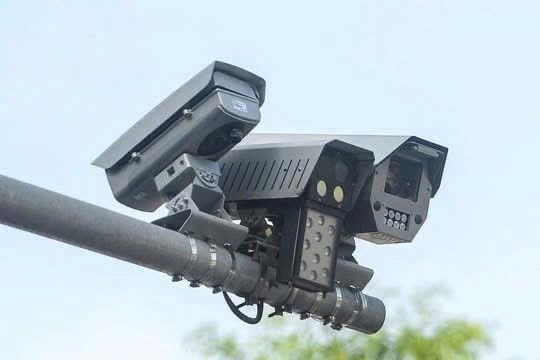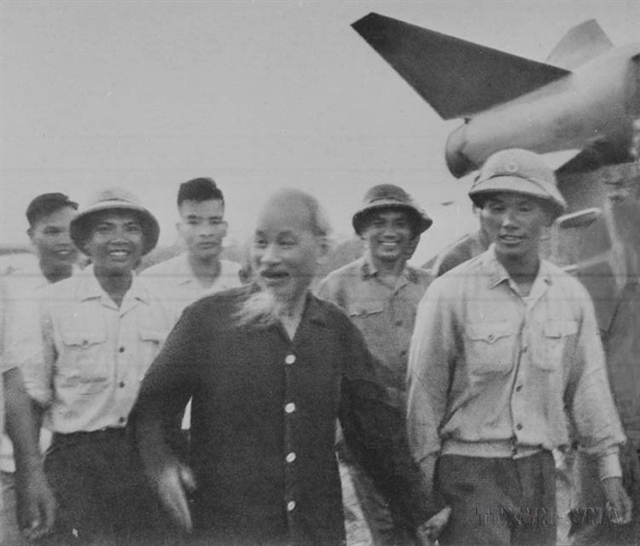 Society
Society

 |
| President Hồ Chí Minh visits Missile Battalion 61, Regiment 236 on August 26, 1965 after the first victory of the Air-Defence Missile Force. VNA/VNS Photo |
Lê Phú
After six decades of building and growing, the Việt Nam Air Defence Missile Force has created a strong and modern force with many glorious feats.
From the first SAM-2 surface-to-air missiles shooting down F-4C fighters to the air battles with B-52s of the US Air Force, the young air defence missile units of the Vietnam People's Army wrote an immortal epic, being the key force protecting the Motherland's sky.
Colonel Trần Mạnh Hiến, 82, Hero of the Vietnam People's Army, is the former commander of SAM-2 Battalion 82, Regiment 238. He is a witness of the air battles in which the first B-52 bomber of the US Air Force was shot down.
“In my 43-year military career, the most memorable memory for me was moving our unit to Quảng Trị battlefield and directly shooting B-52 bombers,” Hiến recalled.
In early 1966, when B-52 strategic aircraft began to bomb the southern area of Military Region 4, the Vietnam People's Army Command decided to choose Air Defence Missile Regiment 238 as the pioneer unit to study how to attack the B-52 bombers - an unprecedented mission.
The operation began in June 1966 and lasted until early 1967, in fierce battle conditions, with locations daily bombed by the enemy aircraft such as the Đồng Lộc intersection and the Gianh River.
Nearly a year later, from January to August 1967, the unit entered an important phase: analysing radar signals, monitoring the flight patterns of B-52 bombers and finding ways to penetrate the dense electronic interference of the enemy aircraft.
“We lost nearly a regiment of soldiers and two regiments of equipment. But by August 1967, we had learned how to detect the real signals of the B-52s. The regiment concentrated its strength on one battalion and entered the battle,” said Hiến.
At 5.34pm on September 17, 1967, in the Quảng Trị sky, Hiến's unit made a miracle. In just over three minutes, two B-52 bombers were shot down. It was the first time this type of American strategic aircraft was shot down by surface-to-air missiles in Việt Nam.
After that, the unit continued to shoot down four more B-52s.
“From practice, we built a document on how to fight B-52 bombers – a basic document that contributed to the glorious victory in the 12-day-and-night campaign against the US air war of destruction against North Việt Nam in 1972”, Hiến said.
Veteran Nguyễn Văn Ninh, former missile operator of Battalion 44, Regiment 263, told a story about himself.
“We were trained in the Yên Thế forest in Thái Nguyên Province, under the guidance of Soviet military experts. After six or seven months of theory and practice, we went into battle, protecting the airspace in southern Hà Nội,” said Ninh.
He and his teammates shot down many modern aircraft such as F-105s, F-4Cs and even drones.
For him, the November 22, 1972 battle in Nghệ An was an unforgettable moment.
“In the missile control cabin, three operators took turns measuring the distance, azimuth and altitude. We operated the radar to direct the missile to hit the target, overcoming all electronic interference from the B-52 and shot it down,” he said.
In 1973, Regiment 263 continued to move into Quảng Trị, protecting the transport route for weapons to the southern battlefields and then participating in the Hồ Chí Minh Campaign.
“On April 30, 1975, we set up a position to protect the Sài Gòn sky. Our regiment was awarded the Military Hero title, and was the first missile regiment to participate in the parade of the South Liberation Army celebrating the total victory over the Sài Gòn regime,” Ninh said.
Stories of heroic combat not only came from the north or big fronts, but everywhere from the sea to the mountains.
Lê Duy Tuý, a veteran of Battalion 94, Regiment 261, Division 361, is one of those soldiers.
“The Sầm Sơn battle in 1967 was fierce. We faced hundreds of US air bombardments, combined with artillery fire from US ships from the sea, but we were not shaken,” Tuý recalled.
He still remembers the battle in Đà Sơn, Nghệ An Province in 1966.
“Although the enemy fire-power was very strong, we still fought persistently, not leaving the battlefield. The great sacrifices made us more determined to keep the nation sky clear in peace,” he said.
Tuý was sent to the Soviet Union for training, then continued to serve in Regiment 278, a unit that later merged into Regiment 261.
“The Air-defence Missile Force’s tradition is steadfastness, precision and determination. That is what I hope today’s young generation will inherit and promote in the new era,” said Tuý.
 |
| Soldiers maintain weapons at Missile Battalion 116, Division 367. VNA/VNS Photo Trọng Đức |
Major General Bùi Thiên Thau, deputy commander of the Air-Defence Missile Force said: “The force has been, is and will be the main force in protecting the Motherland’s airspace. We will continue to invest in modern equipment, meeting the requirements of protecting airspace, sea and island areas in the new era.”
Especially, promoting the role of veterans, those who directly fought, in training and imparting experience is a crucial factor.
“The valuable experiences of previous generations are invaluable assets, contributing to building a disciplined, elite and modern force,” General Thau said.
From the early days with two missile regiments, to today, the Air-Defence Missile Force has become a modern military branch, protecting the national airspace in all situations.
Together with the air force and radar forces, they form a solid and protective layer throughout the country.
For 60 years, the Air-Defence Missile Force has fought, won and matured, creating immortal symbols of the Vietnamese spirit in war and peace. VNS